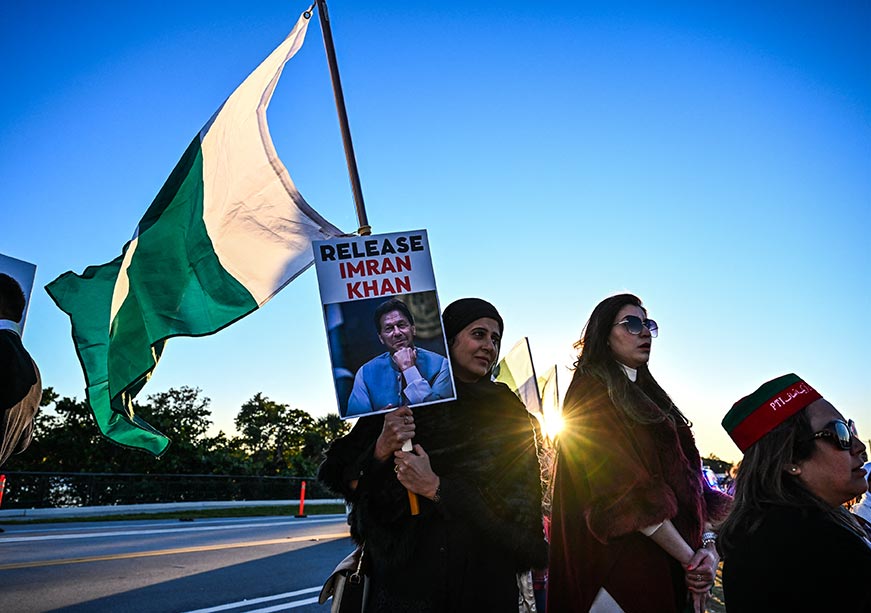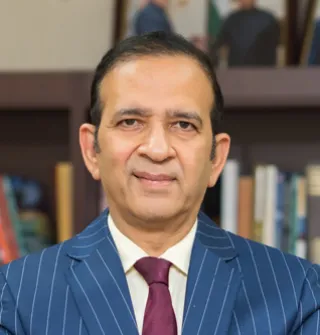-
CENTRES
Progammes & Centres
Location
An imprisoned Imran Khan directing street protests is a thorn in Pakistan army’s side. The political instability deepens Islamabad’s ‘polycrisis’

Image Source: Getty
Pakistan’s Qaidi Number 804, its former cricket captain and PM, Imran Khan, gave another ʻfinal callʼ to his PTI cadre for an assault on Islamabad on Nov 24, exhorting his supporters to ‘fight till the last ballʼ for his release. But in the face of overwhelming force unleashed by the establishment, the match ended on the third day, as an outfoxed third-rung PTI leadership abandoned play.
Imranʼs principal nominee for the battle, his wife Bushra Bibi, aka Pinky Pirni, only recently released from prison, tried to rally the troops, but erred tactically in declining an establishment offer to conduct a sit-in on the capital’s outskirts. Bibi was among those who pledged to remain in the capital ʻtill her last breathʼ, or till Imran was freed.
But in the face of sniper fire, teargas and rumours of assassination plans in Islamabad’s red zone, she fled in the dark to Khyber Pakhtunkhwa (KP), a PTI stronghold, along with CM of the province Ali Amin Gandapur. For the CM, this was the third vanishing act amidst street protests, fuelling speculation of covert deals with the establishment, leaving PTI workers questioning the sincerity and strength of its leaders in the absence of Imran.
PTI supporters likened the crackdown to the military’s brutal actions in 1971 that led to Pakistan’s division.
PTI mobilised some 10,000 protesters, with police action reportedly leaving at least a dozen dead. However, social media claimed the toll was far higher, alleging a “massacre” by the army with bodies removed overnight. PTI supporters likened the crackdown to the military’s brutal actions in 1971 that led to Pakistan’s division. But the protest paled even in comparison to the ‘strawberry revolutionʼ of May 9 last year, when an unprepared army faced rampaging PTI supporters angered by Imranʼs arrest. Imran now faces treason charges for those events, with the prospect of a military trial looming.
Establishment supporters gloated that the ʻsorceressʼ of PTI had been beaten by the ʻmagicianʼ of the establishment, interior minister Naqvi, and that the final call became a ʻmissed callʼ. But a Dawn commentator called the victory ʻpyrrhicʼ, noting that the establishment faced a strengthening adversary and had to lock down Punjab, allowing only KP protesters to reach the capital.
Khanʼs political strategy is familiar. He gained prominence in 2014 with covert ISI backing, leading protests against the 2013 elections that brought Nawaz Sharif to power. This pressure led to Sharif’s resignation in 2017, and Khan’s appointment as PM in 2018, supported by an army seeking a third political force beyond PML-N and PPP.
Now, roles have reversed; the Sharif brothers — Nawaz and current PM Shehbaz — enjoy military support under a hybrid regime propped up in Feb, while Imran remains locked up.
Imran remains a challenge, refusing deals or irrelevance, unlike deposed past politicians, making him a persistent thorn in the side of the army consolidating de jure power.
Pakistan’s military, long the country’s most powerful institution, has lost credibility under Gen Asim Munir. Since assuming command in Nov 2022, Munir has purged PTI sympathisers within the ranks, rigged an election and tightened control over the judiciary. Recently, Munir executed a ʻconstitutional coupʼ by pushing through legislation extending his 3-year term, which was to end in 2025, potentially till 2032 or even for life. To curb dissent, the army has overseen constitutional changes that undermine the judiciary; a pliable ʻconstitutional benchʼ is in place, emasculating the Supreme Court. Yet, Imran remains a challenge, refusing deals or irrelevance, unlike deposed past politicians, making him a persistent thorn in the side of the army consolidating de jure power.
From behind bars, Imranʼs populist rhetoric continues to resonate, particularly among young Pakistanis, middle classes and diaspora angered by the status quo. Overseas, some PTI supporters even fantasise that Trump might intervene to secure Khan’s release. However, in Imran’s absence, his movement is incoherent and scattered. As the dust settled on another failed revolution on D-chowk, conspiracy theories swirled. One suggested that the army may be looking to release a chastened Imran in a few months with a ʻminusʼ deal that delivers a new PTI leader coordinating a parliamentary rather than a street campaign. Another more ominously hinted that Imran may soon be moved from Adiala jail to be executed. As the political tug-of-war continues, Pakistan faces crises far more daunting. The economy remains on the brink of collapse with high inflation, dwindling foreign reserves, and rising unemployment, despite the life support of a recent IMF loan. On the western front, security threats from the deadly TTP have coalesced with the Pashtun and Baloch insurgencies, spooking Chinese investment and adding to the military’s headaches. Imran’s ongoing battle with the establishment reflects a broader structural malaise in Pakistan: the inability of its ruling elite to address the country’s deepening ʻpolycrisisʼ. As the army tightens its grip, it risks further alienating ordinary Pakistanis, most of whom already view the military as part of the problem rather than the solution. Pakistan’s army may have won this latest match against Imran, but it is clearly losing the series.
This commentary originally appeared in The Times of India.
The views expressed above belong to the author(s). ORF research and analyses now available on Telegram! Click here to access our curated content — blogs, longforms and interviews.

Ajay Bisaria is a Distinguished Fellow at ORF. He is also a strategic consultant and commentator on international affairs. He has had a distinguished diplomatic ...
Read More +